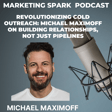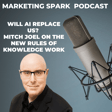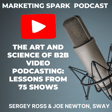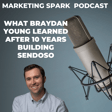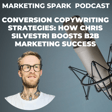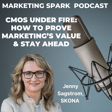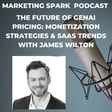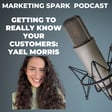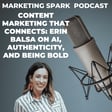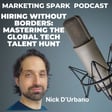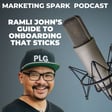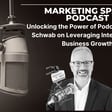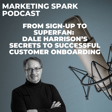Become a Creator today!Start creating today - Share your story with the world!
Start for free
00:00:00
00:00:01

Using Customer Intelligence to Retain Customers: Mike Diaz
As B2B SaaS companies focus on retention rather than acquisition, customer intelligence is becoming more important.
On this episode of Marketing Spark, Mike Diaz talks about the different ways that companies can leverage data and information to keep customers in the fold.
Transcript
The Myth of No Competition
00:00:08
Speaker
If you run into an entrepreneur who boldly claims not to have any direct competitors, don't believe them. They're either lying or operating in blissful ignorance. Every company has dozens, if not hundreds, of competitors battling for customers. To ignore the competition is like cutting off your nose to spite your face.
Outflanking the Competition: Strategies and Insights
00:00:32
Speaker
Now, one of the keys to flanking competitors is having insight and intelligence into who they are, their products, and how they position themselves. On today's podcast, I'm talking with Mike Diaz, who runs Growth Canvas Consulting, a strategic advisory and fractional CMO firm that works with large and small companies. Welcome to Marketing Spark, Mike. Hey, Mark. Thanks for having me on.
00:00:57
Speaker
I was a little dramatic off the top when I talked about entrepreneurs who claim not to have any competitors. But believe me, I've talked to many, many entrepreneurs who make this bold claim. Do you think those people exist or am I just running into unicorns along the way?
Broadening the Understanding of Competition
00:01:19
Speaker
Well, I definitely have met many of those people.
00:01:23
Speaker
I mean, the, the most interesting thing is, you know, we all say that our product is user friendly and, and that we have the streamline solution. Uh, but one of the things that we often ignore is that for, depending upon the job that you have to be done, a better solution can be Microsoft Excel or an intern or, you know, so there's,
00:01:51
Speaker
I think that there needs to be a broad sense of the competition in terms of what are the substitutes? What are the other ways that companies can do a job without your product? And then the other thing that's important to keep in mind is that
Competition vs. Customer Focus: What Matters More?
00:02:14
Speaker
particularly as a small firm, you typically don't have the kind of tentacles out into the market where you're going to see all those new emerging solutions. And you don't have the resources often to uncover those new solutions that are coming in the market. So I think it's important to approach the whole idea of competition with a bit of caution and
00:02:43
Speaker
and care. A competition is an interesting beast because there are schools of thought, people who suggest that you should ignore the competition and just focus on your operations and customers. And there are people on the other side of the spectrum who say you've got to be looking at the competition all the time, know them inside out.
00:03:10
Speaker
Can you explain the polarization of the competitive landscape and how people look at it? Yeah, so I love that you brought that up. That's definitely something that I hear a lot.
Customer Needs as Strategic Compass
00:03:24
Speaker
I guess what I would say is ultimately to have a successful business, you are starting with the customer, right?
00:03:36
Speaker
It's really not the dynamics of the competitor or the particulars of features and benefits that matter the most. It's how are those things perceived by your customers.
00:03:51
Speaker
So, you know, one thing that I would say is really important is you want to be oriented more towards your customers than your competitors. Your competitors shouldn't be dictating your strategy. Your customers should.
00:04:07
Speaker
That being said, particularly as a small firm, you are gonna have pretty large blind spots. We already talked a little bit about competition, but it's a rapidly evolving landscape.
Tools for Competitive Intelligence
00:04:24
Speaker
And to have a little bit more visibility into what your customers are doing or planning,
00:04:33
Speaker
is very critical. You want to be able to counter any efforts that they make. But the other thing that I think is really important is sales enablement. Are you sending your sales rep over the hill with a saber rattling? Are you giving them the tools that they need to do their job to talk about your solution in the context of all the other solutions that are out there?
00:05:02
Speaker
So to have to have the right kind of competitive positioning requires a real understanding of the competitive landscape. So I think as long as you continue to be oriented toward the customer, you're going to be fine. That's the bottom line. So we'll talk about customer intelligence in a bit, but I want to
00:05:32
Speaker
focus a little bit on the competitive landscape and how small and large companies for that matter can start to implement a competitive watch, the idea of monitoring the competition, knowing what kind of moves they're making, what kind of marketing they're doing so that you can be proactive as opposed to reactive. So where do you start in terms of competitive intelligence?
00:05:56
Speaker
I always say that a great place to start is, and I guess this is drum roll please, right? I always say that a great place to start is Google Alerts.
00:06:10
Speaker
But I know everybody laughs when I say that, but how many companies have Google alerts on their competitors, very specific searches and basic searches? And frankly, most companies need to have a Google alert on their own brand, their own products, et cetera.
00:06:32
Speaker
So just in terms of making sure that you're not missing the big signals that are happening in the market, I definitely recommend Google Alerts.
Decoding Competitor Hiring Trends
00:06:44
Speaker
Social media is a treasure trove of information. The availability of insight and data through social is really important.
00:06:54
Speaker
One interesting way to look at where a competitor is focused is to use tools like SpyFu, you know, that actually look at the keywords and what they're doing in terms of keywords. SEMrush also has a good tool set to look at what's going on with SEO and advertising in terms of your competitors.
00:07:23
Speaker
The other thing that I think is important to look at to understand the big picture of what's happening with your competitors, particularly the large ones, is just looking at their hiring. Who are they hiring? A quick look on Indeed can help you to see kind of where their focus is in terms of
00:07:43
Speaker
people planning. So those would be some of the places that that I would start. And you know, the other thing that I would say is sales enablement. Do you have kind of competitive positioning versus your key competitors? That's another place that where I would say got starting. I mentioned off the top that every company has dozens, if not hundreds of competitors, and it may have been over dramatic and
00:08:12
Speaker
saying that, but the question is how many companies should you be actively monitoring? Is it three? Is it five? Is it 10?
Strategic Focus on Key Competitors
00:08:22
Speaker
I mean, for small companies with limited resources, obviously you're only gonna be able to focus on so many. With larger companies, obviously the competitive set can be larger, but is there a rule of thumb when it comes to monitoring competition? And the other angle would be direct competitors.
00:08:39
Speaker
accounting software x versus y quicken versus wave versus indirect competitors and How does how does that come into the mix as well? So, you know, you're not gonna like my answer. It's that it depends right? But really when you look at it what I think is important is
00:08:59
Speaker
that as a first step, you cover the consideration set that you're running into in the marketplace. So when a company is looking at your solution, what are the three or four other solutions that they're typically considering in the market?
00:09:19
Speaker
And then, you know, you really can take a flyer on company that's addressing a different segment. If you're a little bit worried they're going to move up market or something like that, you know, get them into your competitive set. But I would say to be really deep diving on more than three or four companies is probably not a good use of your resources.
Customer Journey and Intelligence Gathering
00:09:44
Speaker
You mentioned that
00:09:47
Speaker
Focusing on customers and knowing them inside out is obviously a key part of outflanking competitors and knowing where the opportunities and the risks exist. Maybe we can do a little bit of customer intelligence 101. Everyone, especially on LinkedIn talks about you have to talk to your customers, you have to know them, you really have to know how they tick, but many marketers don't do it. They're making educated guesses at best. So if you were advising a marketer in terms of
00:10:17
Speaker
having customer intelligence, what steps should they, how should they start when it comes to getting enough insight to do marketing that's relevant and that will resonate.
00:10:29
Speaker
Well, as a first step, I'd suggest staying tuned in to customer websites, social media, et cetera. There's a lot that you can learn. And it's really important that when you're talking to customers that they're not having to explain to you everything about that. So I think to be curious and to be continuing to follow what your key customers are doing is critical.
00:10:59
Speaker
I also think that understanding the buying process that customers are navigating is increasingly critical. Post-COVID, we know that north of 95% of the buyer journey is going to take place without sales interaction.
00:11:23
Speaker
So actually understanding what it is that helps the prospect to see that they have a need and kind of what is the process, who are they consulting, who's involved in the buying process.
00:11:39
Speaker
All those kinds of things are really important. One thing that I'd recommend if you're really trying to get started is to do some win-loss interviews, win-loss and no-decision interviews.
00:11:55
Speaker
So that you can understand kind of what is that process that the customer is going through and that results in a sale. What's the process that they go through and what are the disconnects that occur that result in a loss.
00:12:13
Speaker
And then what's the process look like when there's no decision at all, right? You basically lost to the status quo. So I think doing those kinds of interviews, you know, number one, they help you to improve your marketing and products. But number two, they paved the way for increased win rates moving forward. So I mean, it's just a win-win. That's an area that I want to
00:12:41
Speaker
dig a little bit deeper into because when you win a customer, everybody's happy. The customer's happy because they found a solution that they believe is going to deliver value in ROI. The vendor is happy because obviously they've got a new customer. So that sets the stage for a good conversation where you can circle back with them after the deals been signed and say, just curious about what was it about us that you liked? Who else did you consider? Why didn't you pick them? Okay.
Conducting Win-Loss Interviews
00:13:09
Speaker
So that's fine.
00:13:11
Speaker
but for lost deals and no decision opportunities, that may be a bit more challenging because if you've lost business to a competitor, it's a bit awkward to go to a company and say, well, why didn't you pick us? Our solution is really good. I thought we had a good relationship. I thought we did a good job during the demo or during the sales demonstration. And I'm just disappointed that you didn't pick us. It comes across as,
00:13:41
Speaker
whiny or you're complaining after the fact. And on top of that, it comes across like you're trying to go back in and win the sale, right? Yeah, but that's all true. But what you're really trying to do is just gain insight so that you can do a better job going forward. Maybe down the road, if that customer is disappointed, they may circle back. I'm curious about what your approach is when you're trying to approach a lost or no decision.
00:14:10
Speaker
and position it properly so that they don't think you're trying to win their business. They don't think you're trying to complain. You're just looking for their feedback. So number one, I would say, yes, those conversations are hard to schedule. And I would encourage companies that are looking to do those kinds of conversations themselves to be very clear that this is not a sales interaction. And that might mean
00:14:38
Speaker
Having the whole discussion led by somebody who's not in the sales or marketing functions who happens to be good facilitator the other thing that i would say is it's perfectly okay i think to provide some kind of incentive.
00:14:56
Speaker
If you're going to interview somebody about a lost deal because you know, the honest truth is they don't want to go back and revisit it. And they, you know, they know that you do and they're going to be guarded with their words because it's just a difficult kind of.
00:15:15
Speaker
challenging situation to talk about, I would say that if you're having a situation where you've got a lot of lost deals or a lot of no decision deals, that it might be useful to work with a third party to do those kinds of interviews.
00:15:35
Speaker
just because of the difficulty of kind of being in the middle of that deal and trying to have a nice objective conversation about it.
00:15:46
Speaker
Yeah, I can agree with you on that front because when I'm working with clients and I go out and talk to customers, well, first, they're very leery about me talking to their customers because I'm the outsider and they don't want to do anything that will upset the Apple cart. But when they eventually agree to let me talk to customers and then I talk to them, I tend to have
00:16:07
Speaker
Better conversation because I come in as an unbiased third-party resource and immediately I say this is all off the record It's just for background and they feel because I'm a neutral source that they can be a little more honest and it's always surprising when I go back to an entrepreneur and I say hey I talked to your customer and
00:16:26
Speaker
And they told me A, B, and C, and this is really interesting. The reaction is, in many cases, surprise. It's like, really? They said that? Because they'll never talk to the CEO or the VP marketing like that. So that's just my personal observation on talking to customers.
Importance of Cross-Departmental Intelligence Sharing
00:16:44
Speaker
The one thing I didn't want to ask you is that when you've gathered competitor intelligence and customer intelligence,
00:16:50
Speaker
How do you pollinate it throughout the organization because a lot of this information will sit within the marketing department or the sales department it'll be very siloed and while that department will have this insight going forward there are other departments that will operate in ignorance.
00:17:09
Speaker
When there's great intelligence at their fingertips, they just don't have access to it. So what is the keys to making sure that everybody across the organization knows that this information exists and can take advantage of it? I think a regular cadence of interaction with some of the key stakeholders for the intelligence is really critical.
00:17:33
Speaker
One of the things that often a company will fail to do is really dig into what those intelligence needs look like on the front end. Of course, if you get some information on the front end about what's the info that sales needs to close deals,
00:17:52
Speaker
Then all of a sudden, when you're providing that information, they've requested it. So there's already buy-in built into that system. If you're having regular conversations, you're getting good feedback about what's working and what's not working.
00:18:08
Speaker
There are lots of companies that have internal intelligence newsletters. I've seen success with that. That can be very helpful. I would recommend though that you try to build a lot of these efforts around the CRM. You kind of think about the various systems that
00:18:33
Speaker
the teams are using. So it would be CRM on the sales side, but maybe for customer service, we've got a totally different system. So, you know, plugging in to those various systems and getting the intelligence to where people work is also really important. For smaller companies, when they're reaching out to customers or doing demos or having sales calls,
Aligning Sales and Marketing for Consistency
00:19:01
Speaker
It strikes me as advantageous if marketing and sales are both at the table because in many situations for smaller companies, marketing is sales and sales is marketing. And it's probably a very good thing if they both move in lockstep.
00:19:18
Speaker
They're both on the same page. They're both aware of what prospects are thinking and asking how do marketing and sales at smaller organizations and companies that you work with align themselves so that they're aware of what the customer wants and sales knows the messages to deliver and how to position the product properly. I would say that one of the key things is, uh,
00:19:44
Speaker
to be in close collaboration looking at the entire customer journey. So basically marketing has programs that are kind of digging the well before you're thirsty, right? That don't necessarily have a lot of visibility for the sales teams.
00:20:08
Speaker
But the sales teams can use a lot of the assets from those programs. If there's the collaboration, you need to look at what's going on in the sales process. I think joint sales calls, like you said, are a great idea because you start to see.
00:20:27
Speaker
where the sales team is struggling with the messaging that you have, what products are getting traction, what products are not. And then you can also spend some time talking about upselling customers, kind of what does it look like to upsell this type of customer? What does the upsell path look like?
00:20:52
Speaker
And that's all really important. The other thing that I would say is really important is that sales and marketing be talking about the renewal process.
00:21:03
Speaker
uh, particularly in a, in a subscription type environment, uh, too frequently, I think in small businesses, you're so busy in marketing. You're not necessarily giving yourself that early warning that, uh, a customer subscription might be in danger. And I think with the economy for tech companies in particular moving in the direction that it is.
00:21:31
Speaker
Really keeping your eye on retention is going to be critical. Over the last couple of years, when the B2B SaaS market was growing amazingly well, it was all about acquisition and growth.
Engaging Customers through Community Building
00:21:44
Speaker
Every company had positioned themselves and was spending tons of money on marketing and sales to acquire as many customers as possible because everybody was jumping on the digital bandwagon. Today, the landscape is completely different.
00:21:57
Speaker
Economic volatility, customers are more cautious. They're taking their time before they actually make an act with a purchase. And reducing churn and keeping your customers happy is obviously as important, if not more important. One of the things that I focus on with my clients is how do you educate and engage your customers so they feel like their business is valued? I'm not talking about case studies.
00:22:26
Speaker
But it's more around the idea of making sure that you're having regular conversations with your customers, whether it's a newsletter or a webinar or having a meetup. What kind of advice do you offer your clients, big and small, in terms of making sure that they're building a customer community and it's dynamic, it's fluid. There's back and forth conversations so that their customers feel like, I'm valuable to the business, they care about me and I should stick around.
00:22:54
Speaker
I say the same kind of thing that you're saying, but I frame it in a slightly different way. My feeling is that it's absolutely critical to provide wins for your customers. And what do I mean by that?
00:23:11
Speaker
I can't tell you how many situations I've seen where there's a customer advisory board or a focus group or something and two people from your customer group actually meet each other and it helps to drive both of their careers. It's helping to introduce them to people who can help solve their other problems that don't involve your product.
00:23:38
Speaker
giving them tools to be more successful in their role that don't have to do with your product. It's providing them with information that can help them to navigate some tricky situations in the market. So from my standpoint, yes, it's the regular contact.
00:24:03
Speaker
But there just has to be some thinking about how can I bring some wins to my customer to make their week go better. And a lot of people also frame it from the standpoint of value. They buy your product because or subscribe your product because they see some potential value that it's going to bring.
Discussing Expected Value with Customers
00:24:31
Speaker
To what extent are we having those conversations up front you know what value do you expect from this product over the subscription cycle and checking in and okay so that's our litmus test for value how are we doing at this stage rather than you know a month before the renewal hey remember me.
00:24:54
Speaker
So it's a, it's a, it's really important, I think, to, to think about value, to think about customer wins. And I think to the extent that the customer wins don't really involve, you know, your product directly, it really casts your organization in a very positive light. The thing about software is that there's obviously a big focus on the technology, but at the end of the day, it's really about helping people get jobs done.
00:25:25
Speaker
making them more efficient, more productive, more successful, healthier, whatever the case may be. I think where a lot of companies drop the ball is that they spend a lot of time trying to convert a prospect into a customer. Once they've got them in the fold, they forget about them. They take them for granted.
00:25:47
Speaker
They don't market to them. They don't sell to them any longer or as aggressively or as enthusiastically as they should. And I think that's a big weakness for a lot of companies because when they do come up for renewal, a customer say, well, I haven't heard from you in ages. You haven't really given me any insight at how I can extract more value from the product. I just don't feel that, that loving feeling from you. And then they start to wander and explore their options.
00:26:14
Speaker
I think what you're saying is, love your customers, engage them, keep offering them value, show them how they can win more. And at the end of the day, it'll be a win-win proposition.
Customer Retention vs. Acquisition
00:26:25
Speaker
Yeah. I mean, the cost of retaining your current customers is going to be way lower than acquiring new ones. And, um, in a choppy market environment, you really want to hold an upsell your customers and generate positive word of mouth that that can be the difference between a big year and kind of a mediocre year. One final question.
00:26:51
Speaker
If you're a marketer, a B2B SaaS marketer, or a B2B marketer right now, and you're looking at the economic landscape, and you're trying to figure out what levers to pull, what decisions to make because everything is rather uncertain, what advice would you offer them from an intelligence point of view, a competitive intelligence, customer intelligence point of view, so that they're pulling the right levers, making the right decisions, spending their money in the right places?
Leveraging Small Company Advantages
00:27:18
Speaker
Is there some fundamentals that they should
00:27:20
Speaker
focus on because often there's a lot of exciting and shiny new things when it comes to marketing, but often it comes back to the fundamentals and paying attention to the things that matter. What's your advice in terms of how they can move forward more confidently?
00:27:33
Speaker
Yeah, I think particularly for small companies that are trying to navigate in this environment, you really want to try to find ways to create an asymmetric advantage over kind of a large company. And what do I mean when I say that? I mean that, for example, a small company is by its very nature, very nimble, right?
00:28:02
Speaker
So to the extent that they can know the customer better i mean i've been at you know development team discussions in small companies where they just say okay can we get that feature in there now right.
00:28:18
Speaker
And if you're in a big company, that's really not so possible. So I would just look for areas where you can play to your strengths as a smaller company to gain an advantage that's really not something that can be replicated by your competitors. Final, final question.
Connect with Mike Diaz for Further Insights
00:28:42
Speaker
Where can people learn more about you and what you do?
00:28:44
Speaker
They can follow me and connect with me on LinkedIn. I'm at MikeHDS on LinkedIn.
00:28:54
Speaker
look forward to some good conversations. Awesome. Well, thanks for the great insight, Mike. I'm a big believer in the value of customer and competitive intelligence. The more I know about your customers, the more you know about your competitors, the more success your marketing and sales will be. So thank you for having a great conversation on Marketing Spark. And thanks for everyone for listening to another episode of Marketing Spark. If you enjoyed the conversation, leave a review, subscribe via Apple Podcasts, Spotify,
00:29:22
Speaker
or your favorite podcast app, and share via social media. To learn more about how I work with B2B SaaS companies as a fractional CMO, strategic advisor, and positioning and messaging consultant, email mark at markevans.ca or connect with me on LinkedIn. I'll talk to you next time.

